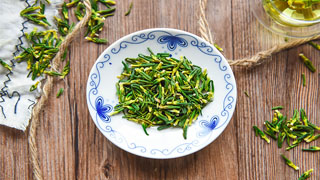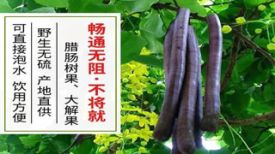
1. Aliases
Job's tears, bitter Job's tears, lotus Job's tears, lotus heart.
2. Plant morphology
Perennial aquatic herbs. The plant height is 1-2 meters. The rhizome is thick, running horizontally underground, with a yellow white outer skin, scaly leaves and adventitious roots at the nodes, swollen internodes, spindle shaped or columnar, and honeycomb shaped pores inside. Leaves basal, petiole long, cylindrical, hollow, with black hard spines. The leaves are shield shaped and circular, with a diameter of 25-90 centimeters. They are wavy throughout and protrude from the water surface. The upper part is pink green, and the lower part is light green. The veins of the leaves are radial. The flower is large, 10-25cm in diameter, pink or white, fragrant. Sepals 4-5, green, small, early setting. Petals numerous, elliptical, apex pointed. Most stamens, early setting, slender filaments, linear yellow anthers, with rod like appendages at the tip of the septum. Nuts (lotus seeds) are oval or oval shaped, measuring up to 1.5 centimeters in length and gray black in color. The seeds are oval shaped, and the seed coat is reddish brown. The flowering period is from July to August, and the fruiting period is from August to September.
3. Origin distribution
Born in paddy fields or ponds. Distributed in Liaoning, Hebei, Henan, Shaanxi, Gansu, Shanxi, Shandong, and various provinces and regions south of the Yangtze River, mainly produced in Fujian and Hunan.
4. Harvesting and processing
When the fruit ripens in autumn, cut off the lotus house, harvest the fruit, take it out, and dry it in the sun.
5. Characteristics of medicinal herbs
Slightly cylindrical in shape, 1-1.4 centimeters long, with a diameter of approximately 0.2 centimeters. The young leaves are green, one long and one short, rolled into an arrow shape, with the tip folded downwards. Small embryonic buds can be seen between the two young leaves. The embryonic root is cylindrical, about 3 millimeters long, and yellow white. Brittle in texture, easy to break, with several small holes on the cross-section. Mild qi, bitter taste.
6. Nature, taste, and meridian tropism
Cold in nature and bitter in taste. Return to the Kidney Meridian and Heart Meridian.
7. Effect and function
Clear the heart and calm the mind, communicate with the heart and kidneys, astringent essence and stop bleeding. A nourishing and tranquilizing medicine that belongs to the subcategory of sedatives.
8. Clinical applications
Dosage 2-5 grams, decoct or add powder. Used to treat heat entering the pericardium, dizziness and delirium, heart kidney failure, insomnia and nocturnal emissions, blood heat and vomiting.
9. Pharmacological research
1. Hypotensive effect: Lotus seed heart decoction has a hypotensive effect on anesthetized cats. The effective ingredients are lotus seed alkaloids and methyllotus seed alkaloids; The hypotensive effect of the crystalline part is brief, and it turns into quaternary ammonium salt (O-methyl-L ü neferine methyl sulfate quaternary ammonium salt), which produces strong and long-lasting hypotensive effects when administered intravenously to anesthetized cats and dogs. The mean blood pressure (MAP) of anesthetized rats decreased after intravenous administration of methylenediamine. Methyl lotus seed alkaloid also has a significant antihypertensive effect when administered through the duodenum of rats, and there is no significant change in heart rate at the corresponding time. Methylneferine also has a significant antihypertensive effect on both renal and DOCA salt induced hypertensive rats. Anesthetized cats and conscious rabbits also showed a significant decrease in blood pressure after intravenous injection of methylenediamine. Methyl lotus seed alkaloid has antihypertensive effects on different animals and administration routes. 2. Anti arrhythmic effects: Methylenediamine has a wide range of anti arrhythmic effects.
10. Chemical composition
Lotus seed heart contains lotus seed alkaloids, isolotus seed alkaloids, methyllotus seed alkaloids, lotus leaf alkaloids, prolotus leaf alkaloids, cowhorn alkaloids, methylviolin, demethyl Hengzhou wuyao alkaloids, subminiavine alkaloids, lotus seed alkaloids, 4 '- methylHengzhou wuyao alkaloids, as well as luteolin, hyperoside, and rutin, β - sitosterol, β - sitosterol fatty acid esters, palmitic acid, unsaturated ketones, and chlorophyll.
11. Taboos for use
Those with spleen and stomach deficiency and cold should not take it.
12. Compatibility prescription
① For those who suffer from Taiyin Warm Disease, excessive sweating, and delirium: three coins for Xuanshen Heart, five cents for Lianzi Heart, two coins for Bamboo Leaf Rolling Heart, two coins for Forsythia Forsythia Heart, two coins for Rhinoceros Horn Tip (grinding, flushing), and three coins for Lianxin Maidong. Boiled in water. (Qing Gong Tang from "Wen Bing Tiao Bian")
② Treating long-term deficiency and leakage of semen loss: a pinch of lotus seed heart, a fraction of cinnabar. At the end. Take two coins per serving, and pour in the hollow white soup. (Cited from "Health Prescriptions" in "Medical Statistics of Ancient and Modern Times")
③ Treatment for hemoptysis and vomiting: Seven lotus seed hearts and twenty-one glutinous rice grains. Above is the end. Mix and match with alcohol. (Lianxin San in "Continuation of Yi Jian Fang Lun")
④ To treat vomiting blood: five coins of glutinous rice and seven lotus seed hearts. At the end of the year, Chen Mo Jue Wan was as big as a wuzi and defecated as a child. (Four Simplified Formulas for Scientific Research)
⑤ Treating vomiting in children: seven lotus seed hearts, three cloves, and three inches of ginseng. The upper part is fine powder, wrapped in milk like cotton, dipped in milk juice and applied with medicine, so that the child can sip it. (Puji Fang)
The content of the article is for clinical reference only. Non professionals in traditional Chinese medicine are not allowed to try medication.


